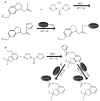Production and Selection of Antibody-Antigen Pairs for the Development of Immunoenzyme Assay and Lateral Flow Immunoassay Methods for Carbofuran and Its Analogues
- PMID: 35892457
- PMCID: PMC9332470
- DOI: 10.3390/bios12080560
Production and Selection of Antibody-Antigen Pairs for the Development of Immunoenzyme Assay and Lateral Flow Immunoassay Methods for Carbofuran and Its Analogues
Abstract
To produce a sensitive monoclonal antibody (mAb) for the simultaneous detection of carbofuran, benfuracarb, carbosulfan and 3-hydroxy-carbofuran, 2,3-dihydro-2,2-dimethyl-7-benzofuranmethanamine (DDB) was conjugated to bovine serum albumin (BSA) to prepare the immunogen DDB-BSA and mice were immunized. Coating antigens were prepared by conjugating DDB and 5-methoxy-2,3-dihydrobenzofuran-3-acetic acid (MDA) to BSA and ovalbumin (OVA), respectively. Furthermore, the effect of different antibody-antigen pairs on the sensitivity of ELISA and LFIA methods for the detection of carbofuran was investigated. After the immunization, a high-affinity mAb 13C8 was obtained. The ability of the coating antigen to compete with carbofuran for binding antibodies was found to be significantly different between ELISA and LFIA methods. With the antibody-antigen pair 13C8-MDA-OVA, the IC50 values of the ELISA and QD-LFIA methods for carbofuran were 0.18 ng/mL and 0.67 ng/mL, respectively. The cross-reactivity (CR) values of the two methods for benfuracarb, carbosulfan and 3-hydroxy-carbofuran ranged from 72.0% to 83.7%, while, for other carbamate pesticides, the CR values were less than 1%. The spiked recoveries of carbofuran in vegetables by the QD-LFIA method were 83-111%, with a coefficient of variation below 10%, and the test results of the actual samples were consistent with the HPLC-MS method. Overall, this study provides key materials for the development of immunoassays for carbofuran and its analogues, and the antibody-antigen pair selection strategy established in this study provides useful insights for the development of sensitive immunoassays for other compounds.
Keywords: benfuracarb; carbofuran; carbosulfan; immunoassay; monoclonal antibody.
Conflict of interest statement
The authors declare no conflict of interest.
Figures





Similar articles
-
Development of monoclonal antibody-based immunoassays to the N-methylcarbamate pesticide carbofuran.J Agric Food Chem. 1999 Jun;47(6):2475-85. doi: 10.1021/jf981184s. J Agric Food Chem. 1999. PMID: 10794653
-
Preparation of a multi-hapten antigen and broad specificity polyclonal antibodies for a multiple pesticide immunoassay.Anal Chim Acta. 2007 Mar 28;587(2):287-92. doi: 10.1016/j.aca.2007.01.052. Epub 2007 Jan 25. Anal Chim Acta. 2007. PMID: 17386785
-
A broad-spectrum antibody-based lateral flow immunoassay for detection of carbofuran and 3-hydroxy-carbofuran.Food Chem. 2025 Feb 15;465(Pt 2):142062. doi: 10.1016/j.foodchem.2024.142062. Epub 2024 Nov 14. Food Chem. 2025. PMID: 39561600
-
Validation of a monoclonal enzyme immunoassay for the determination of carbofuran in fruits and vegetables.J Agric Food Chem. 2001 Apr;49(4):1713-9. doi: 10.1021/jf001171q. J Agric Food Chem. 2001. PMID: 11308315
-
Development of an enzyme-linked immuno-sorbent assay (ELISA) method for carbofuran residues.Molecules. 2008 Apr 17;13(4):871-81. doi: 10.3390/molecules13040871. Molecules. 2008. PMID: 18463589 Free PMC article.
Cited by
-
Quantitative Detection of Biological Nanovesicles in Drops of Saliva Using Microcantilevers.ACS Appl Mater Interfaces. 2024 Jan 10;16(1):44-53. doi: 10.1021/acsami.3c12035. Epub 2023 Dec 29. ACS Appl Mater Interfaces. 2024. PMID: 38157306 Free PMC article.
-
Biosensors and Bioassays for the Medical Detection of Bacillus Anthracis and Diagnosis of Anthrax.Curr Med Chem. 2025;32(16):3123-3133. doi: 10.2174/0109298673310620240704132204. Curr Med Chem. 2025. PMID: 39005126 Review.
References
MeSH terms
Substances
Grants and funding
LinkOut - more resources
Full Text Sources
Medical

